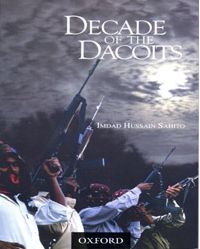Bandit Kings
By Saad Akhtar | Arts & Culture | Books | Published 19 years ago
 For those who traversed the roads of Sindh province during the 1980s and ’90s, the presence of the Sindhi dacoit posed a constant threat to the safety of life and property. Trains, cars, buses and cargo trucks were all looted and enough kidnapping cases resulted to scare the provincial and federal government into action in the early 1990s.
For those who traversed the roads of Sindh province during the 1980s and ’90s, the presence of the Sindhi dacoit posed a constant threat to the safety of life and property. Trains, cars, buses and cargo trucks were all looted and enough kidnapping cases resulted to scare the provincial and federal government into action in the early 1990s.
Imdad Hussain Sahito’s work, Decade of the Dacoits, brings this period to the fore with a well researched critical analysis of the history and activities of the dacoits, as well as tackling the key issues of the reasons for their emergence and the steps taken by the government to combat them.
The dearth of quality English language works coming out of Pakistani universities is alarming . Sahito, a professor at Shah Abdul Latif University, with a PhD in Criminology, has produced a model for emulation with this book.
That said, this book is by no means an easy read. What little flow exists in the text is broken by the sub-headings on each page. Although each section is linked to the previous and is a logical continuation of the one preceding it, the demarcations make it seem detached from the rest of the text.
Despite these limitations the content itself is informative without being dull. Sahito merges stories with analysis and produces rather poignant accounts of the rise and fall of dacoits in Sindh.
He begins by placing the entire concept of highway robbery and kidnapping in the region into a historical context. He talks of the pirates that roamed the high seas before the British showed up. He discusses the looting and plundering that took place in each historical period in Sindh, with distinctions based on who ruled Sindh at the time.
After having established historical relevance, he moves onto the recent epidemic rise and its causes. He implicates the social setup, the tribal nature of rural life in Sindh, which fosters rivalries, the political and tribal affiliations, the role of the state and judiciary and the inefficiencies of the police. Sahito is particularly critical of the law enforcement agencies and their agents in Sindh. He dedicates large portions of his analysis to recording the inefficiencies and corruption that were rife in the Sindh police force during the years from 1984-1994.
In fact, police forces are directly implicated in the rampant kidnappings of that ten-year period. According to Sahito, the police, as informers, helpers and supporters of the dacoits and kidnappers, received a cut of the earnings. Not only did police involvement provide official cover for the dacoits and kidnappers, it also complicated the task of bringing these outlaws to justice.
Sahito’s study shows that “a majority of the people were kidnapped within a radius of one mile from the police station. Whenever possible, the police avoided encounters with the dacoits.” This was either due to fear of repercussions-police officers themselves were killed or kidnapped-or due to direct involvement on the part of these officers.
These activities were not restricted to rural and backward areas of Sindh but seeped into Karachi as well. Between 1984-94, Sahito lists a number of incidents of kidnapping and dacoity that took place in the city, including those that were aided and abetted by the police.
It was only in 1992 that the government decided to step in and take effective action against the perpetrators. Sahito discusses these moves in detail. According to him, the most effective was Operation Blue Fox in 1992 when the Pakistan army was ordered into Sindh to combat the dacoits. However, he goes on to list a number of cases in which the Rangers and police were both responsible for torture, murder and rape of innocent civilians and the pillaging of towns.
This book, written after years of research by Sahito, is one step in the direction towards exposing the corruption, lawlessness and crime that pervades the province . With this book as a stepping stone, it is now imperative that measures be taken to eradicate the problems and provide relief to the people of Sindh.
As an academic exercise, Sahito’s work is comprehensively researched and mostly well-written. Oxford University Press, Pakistan must also be lauded for continuing to promote the publication of indigenous writing and academic works.


